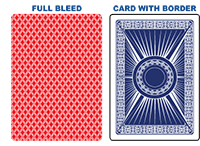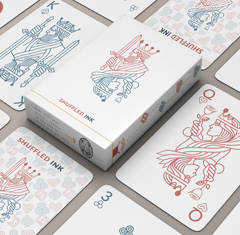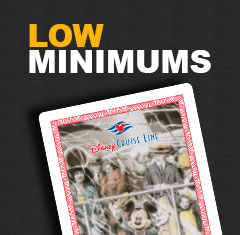About Customized Playing Cards
Playing cards have become one of the most popular blank canvases for digital artists. Cards offer two surfaces that can be designed in any way shape or form. As long as the number and some form of a suit appear somewhere on the face, the designer can do anything he wants. Cards can have color, intricate designs, text, and photos printed on them. Images can be manipulated and words can appear in any number of fonts.
Playing Card Sizes: Poker and Bridge
The two most common sizes of playing cards are Poker and Bridge.

Poker size cards
(by far the most common)
Size: 2.5″ x 3.5″
Outer Bleed: 2.625″ x 3.625″
Live Image “Safe Print Area”: 2.125″ x 3.125″
Bridge size playing cards:
Size: 2.25″ x 3.5″
Outer Bleed: 2.4″ x 3.625″
Live Image “Safe Print Area”:
1.875″ x 3.125″
We can also produce any custom sized or shaped cards, customized to your specs
(custom minimums apply).
Playing Card Sides: Backs and Faces
One common source of confusion is which side of the card is which. The card sides are commonly referred to as Backs and Faces.
Playing Card Faces
The faces of cards are the sides containing the “pips” (corner suits and digits). When printing custom backs and faces, you have, essentially, 55 blank canvases- one for the backs of all cards (see below) and one for each of the 54 card faces (two jokers plus Ace through King of spades, hearts, clubs and diamonds).
Playing Card Backs
The common side of the deck is called the “backs“. With the exception of flash card type decks, the back should be the same for every card in the deck. Otherwise your deck would be a “marked” deck (players would be able to tell what cards you are holding based on the backs they see).
When ordering custom backs only, you choose one design for the backs of all cards and have the choice of generic standard faces or generic faces with jumbo pips. Modification of ANY elements of the faces (including design, color or font) makes the order custom backs and faces.
Playing Card Stocks- Paper or Plastic?
There are two types of playing cards- Paper and Plastic, each available in several different varieties.
Paper Playing Cards
All of our paper playing cards are durable, uv plastic coated, and are available in several card weights and options.
Playing Card Stock is measured in GSM (Grams per Square Meter). Paper stocks are available in 280gsm, 300gsm and Casino Quality 310gsm and 330gsm. There are also two “core” options- White Core and Black Core. Standard cards are white core, meaning the layers the card stock is made up of are all white. Black Core card stock has a center layer of opaque black paper, laminated with white outer layers, making the cards opaque, even when held up to a light.

100% Plastic Playing Cards
For an even more durable, waterproof card, try plastic playing cards.
Our plastic card card stock is completely comparable, in both material and quality, to KEM cards. Plastic playing cards can last a lifetime!
Card Designs
When personalizing your cards, you can consider them blank canvases on which your design is printed. You can print anything you would like on the cards- photos, illustrations, logos, text or any combination you can think of.

Full Bleed or Borders
“Bleed” is if your images extend right to the edge of your card. Due to the process of printing and cutting cards, any art that extends right to the edge of the card must actuall print beyond the edges… this image area outside the card itself is called “bleed”. Anything that does not bleed off the card, including text and logos as well as image elements such as borders, must stay within the live image “safe area” (see graphics & templates for specs). Repeating patterns are also discouraged within this outer border, as even a slight variation in cut can become very noticable.
Playing Card Design
You may provide completed, “camera ready” art in virtually any graphics format, although, when possible, vector art (such as Adobe Illustrator or Corel Draw) is preferred due to the increased clarity produced from vector as opposed to raster (bitmap) art. It is also preferable to submit art in their native format (ie- photoshop art as a psd file, as opposed to in jpg format).
How To Submit Your Art
In addition to using the native format of your chosen software, please make them as editable as possible. In the case of photoshop images, please leave all layers intact so the art can be manipulated, if necessary to fit to specs. In vector formats such as Corel Draw and Adobe Illustrator, please convert all text to curves (outline text) and either embed all placed images, or provide the linked art along with your vector files.
For raster images, please be sure they are at least 300dpi at the size they will be printed. If you cannot produce the designs you would like, we will work with you to design your cards exactly as you would like them.
If you are customizing both backs and faces, please provide individual files for each card and name accordingly (ie- as.pdf for ace of spades, 2d.pdf for 2 of diamonds).
If your artwork is under 10MB you can simply attach it to an email. For larger transfers contact us for online submission login info. If you are sending many individual files (such as one file for each face) please combine them all into one archive, such as zip, rar or stuffit archives.









